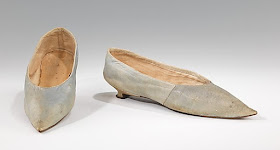We have an 1813 ball coming up soon, and new dancers ask what they should do about shoes. Our rule of thumb is that if you don't have exact historical reproductions, wear something that is unobtrusive.
Our men usually wear black oxford shoes with leather soles. They could be made for dancing, or made for dress. If you choose to wear dress oxfords, make sure that they are not heavy; some current styles have very thick and heavy soles. Dance oxfords look like this:
My favorite shoe has a ballet upper and leather sole. Sometimes you can't find a completely flat sole, but end up with a classic ballet sole, that doesn't cover the entire bottom of the foot. This is less comfortable, but still acceptable. You can also find shoes of this style at Payless and other shoe stores. Just make sure that the soles are not too slick (plastic) or too sticky (rubber). Ballet flats look like this:
There is a new shoe being sold by
The American Duchess that has many of the features of an early nineteenth century shoe. It looks like this:
Of course, the best sort of dancing shoes for early nineteenth century wear are in museums. Here is a selection of shoes from the Metropolitan Museum of Art:
 |
| Blue Slippers 1790-99 |
 |
| Blue Slippers 1795-1810 |
 |
| Tan and Black Slippers 1812 |
|
 |
| Blue Slippers 1815-20 |
 |
| White Slippers 1805-15 |
 |
| Men's shoes 1800-1850 |
|
I included a photo of men's shoes that look like dance oxfords to show that the dance oxfords are a reasonable choice. In this period, men would be more likely to wear pumps for dancing. Pumps are low cut, like the ladies' slippers above. I haven't found a photo of men's pumps from the right time period.
This picture of shoes in a museum in Australia is identified as women's shoes, but I wonder if they are men's dress shoes.
 |
| Shoes 1780-1810 |
|











Ooo!!! Eye candy! :)
ReplyDeleteQuinn